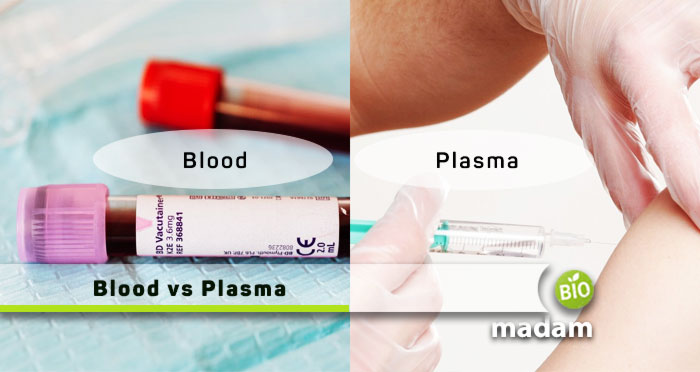Blood and plasma have always been interchangeably used in layman’s terms. Yet if you are a biology student or belong to the medical profession, you must understand that both are quite different from each other. Plasma is a component of blood, and people commonly assume that it is okay to use one in place of another; it can lead to issues if they cause a misdiagnosis. Differences between blood and plasma are not multiple. However, they must be understood well so as not to confuse one with the other.
Comparison Table
| Factor | Blood | Plasma |
| Definition | The red liquid in the body | Part of blood |
| Amount | Five liters | 55% of blood |
| Composition | Plasma, RBCs, WBCs | Proteins, hormones, platelets, antibodies, etc. |
| Functions | Micro and macronutrient transport | Regulating temperature, pH, waste material transport, etc. |
| Major role | Oxygen transport | Increases blood volume |
| Color | Red | Yellow |
| Donation | Multiple laboratory tests | No tests |
What is Blood?
You might know blood is the red liquid that comes out of your body when you cut yourself or experience physical trauma. Blood is a critical component for our survival as it is involved in oxygen transport toward the brain and other parts of the body. It also contains nutrients essential for body processes and growth.
Whatever goes into the stomach through ingestion moves to the small and large intestines, where the essential nutrients are absorbed and sent into the bloodstream. Blood gets its bright red color from oxygenated blood and hemoglobin. It is the main protein present in blood just as myoglobin is for muscles. These cells die every 120 days and are replaced by new ones.
Composition of Blood
Blood is about 55% plasma combined with red blood cells, white blood cells, and platelets. Red blood cells are responsible for oxygen transport, white blood cells help fight pathogens, and platelets help heal wounds. Plasma contains other elements like glucose, hormones, neurotransmitters, minerals, vitamins, antibodies, etc.
Functions of Blood
- It supplies oxygen to all body parts.
- It helps remove waste products from the tissues.
- Blood helps regulate the pH and temperature of the body.
- It helps cuts and wounds clot immediately through platelets.
What is Plasma?
Plasma is the main component of the blood and contains a large amount of water. Besides water, it contains hormones, simple carbohydrates, like glucose, proteins, electrolytes, clotting factors, carbon dioxide, and little amount of carbon monoxide (naturally produced in the body as a hemoprotein turnover). It is yellow in color as red blood cells are not a part of the plasma. You may say that the liquid part of blood is apart from the large molecules in plasma.
Composition of Plasma
90% of plasma is composed of water, while the rest 10% are proteins, vitamins, nutrients, ions, dissolved gasses, and waste. It also contains antibodies (that help fight against the antigens), proteins, protein albumin, coagulation factors, fibrinogen, etc. It contributes to numerous functions in the body including clotting. Clotting is the process of healing wounds and preventing blood loss.
Functions of Plasma
- It majorly aids in clotting.
- It performs immune functions in the body.
- Plasma maintains the fluid balance in the body by regulating electrolytes.
- It acts as a reserve for different types of proteins in the body.
- It is involved in transporting nutrients, hormones, carbon dioxide, and other components.

Difference Between Blood And Plasma
Definition
Blood
Blood is the main liquid component of the body that contains Plasma, RBS, WBCs, and platelets.
Plasma
Whereas plasma is the liquid part of the blood.
Approximate Quantity
Blood
An average adult has around five liters of blood in the body.
Plasma
Though, plasma is 55% of the blood (around 3 liters in the human body).
Composition
Blood
Blood is composed of Red blood cells, white blood cells, platelets, and plasma with all hormones and proteins.
Plasma
Alternatively, plasma constitutes platelets, proteins, and hormones.
Functions
Blood
Blood helps in oxygen transportation to all body parts. Moreover, the WBCs in the blood fight against various infections and diseases.
Plasma
Contrarily, plasma helps regulate the body’s pH and temperature, along with transporting waste materials.
Major Role
Blood
The major role of blood is transporting oxygen, macro, and micronutrients.
Plasma
Whereas plasma mainly contributes to adding volume to blood.
Color
Blood
Blood is red in color.
Plasma
When plasma is extracted from blood, it typically has a yellow hue.
Donation
Blood
Blood donation requires multiple tests to ensure no counter-reaction occurs after blood transfusion.
Plasma
In comparison, there are no such incompatibilities issues associated with plasma.

Difference Between Plasma and Serum
Plasma and serum are quite similar to each other, and you may say that serum is a part of the plasma. While plasma is the liquid part of the blood obtained after removing blood cells, the serum is the part of plasma left after removing clotting factors. It is also called the liquid from plasma left after clotting. The serum is sometimes prepared by adding anticoagulants to blood plasma.
FAQs
What is plasma used for?
Plasma is transfused to various types of patients, including burn and shock patients, trauma patients, clotting factor deficiency patients, and liver diseases.
What is plasma donation?
To collect plasma to administer to a patient, blood is taken from one arm and run through a machine that separates plasma from other blood components.
Does blood type matter for plasma?
Yes, blood group matters when you donate plasma, but in a different way than blood donation. AB blood group is considered a universal plasma donor group, as opposed to blood donation. Yet, they can receive only AB-type plasma. If only platelets have to be extracted from plasma, considering the blood type is not highly critical.
Can I donate blood?
Any healthy individual above the age of 18 with 50 kg or more weight can donate blood and plasma. Their medical history must be taken along with screening for harmful microorganisms, like viruses and bacteria, and other contagious diseases that pass through blood. If the person is cleared of any such diseases, they can donate blood for plasma or blood needs.
The Bottom Line
While blood and plasma are typically used interchangeably, they hold critical value when being transfused to patients. Some people may only require plasma, while others need blood because of red blood cell deficiency. Plasma is essential to form blood, and blood plays a major role in the transport of macro and macromolecules throughout the body.

Hi, my name is Eva. I am currently practicing as a clinical social worker, that being my childhood desire. As a licensed therapist holding MPhil in Clinical Psychology, I am now on biomadam to provide the natives with the best family advice! Do you have any questions? See you in the comment section.

